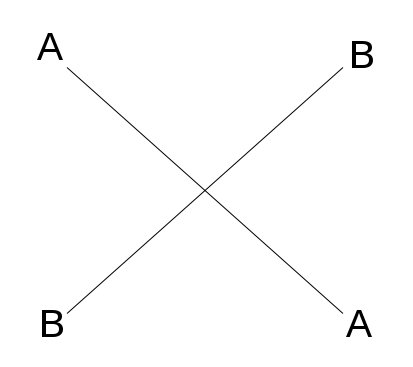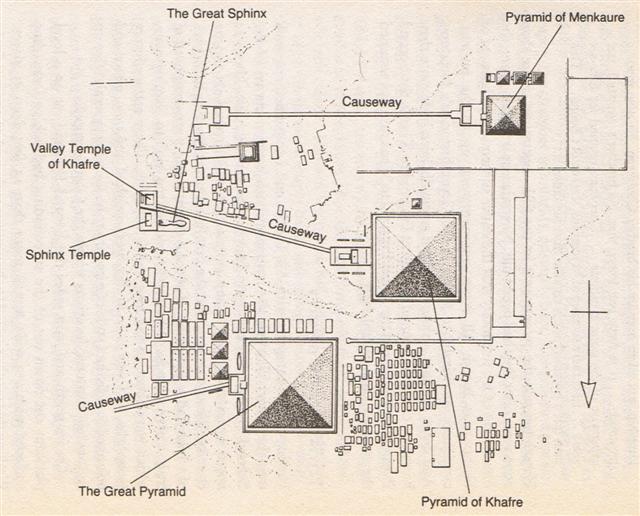The 3 great pyramids in Egypt are relevant too:
... The 3 stars in the Belt of Orion have been used to explain the curious dislocation in the arrangement of the 3 great pyramids in Giza:
'Bauval realized that an areal viw of the Giza necropolis would show the Great Pyramid of Khufu occupying the position of Al Nitak, and the Second Pyramid of Khafre occupying the position of Al Nilam, while the Third Pyramid of Menkaure was offset to the east of the diagonal formed by the other two - thus completing what seemed at first to be a vast diagram of the stars.' (Graham Hancock, Fingerprints of the Gods.)
In Wikipedia another explanation is offered:
'Menkaure was allegedly a much more benevolent Pharaoh than his predecessors. According to legends related by Herodotus, he wrote the following:
This Prince (Mycerinus) disapproved of the conduct of his father, reopened the temples and allowed the people, who were ground down to the lowest point of misery, to return to their occupations and to resume the practice of sacrifice. His justice in the decision of causes was beyond that of all the former kings. The Egyptians praise him in this respect more highly than any other monarchs, declaring that he not only gave his judgements with fairness, but also, when anyone was dissatisfied with his sentence, made compensation to him out of his own purse and thus pacified his anger.
The Gods however ordained that Egypt should suffer tyrannical rulers for a hundred and fifty years according to this legend. Herodotus goes on:
An oracle reached him from the town of Buto, which said 'six years only shalt thou live upon this earth, and in the seventh thou shalt end thy days'. Mycerinus, indignant, sent an angry message to the oracle, reproaching the god with his injustice - 'My father and uncle,' he said 'though they shut up the temples, took no thought of the gods and destroyed multitudes of men, nevertheless enjoyed a long life; I, who am pious, am to die soon!'
There came in reply a second message from the oracle - 'for this very reason is thy life brought so quickly to a close - thou hast not done as it behoved thee. Egypt was fated to suffer affliction one hundred and fifty years - the two kings who preceded thee upon the throne understood this - thou hast not understood it'. Mycerinus, when this answer reached him, perceiving that his doom was fixed, had lamps prepared, which he lighted every day at eventime, and feasted and enjoyed himself unceasingly both day and night, moving about in the marsh-country and the woods, and visiting all the places he heard were agreeable sojourns. His wish was to prove the oracle false, by turning night into days and so living twelve years in the space of six.'
The order was to have Menkaure at the end, after Khufu and Khafre, and thus with time moving withershins compared to the right ascension of the stars. This fact is alluded to in the last sentence, where Menkaure was counted to 12 by living also in the nights (like the moon).
150 (ordained by the Gods) + 6 ('nights' turned into 'days') = 156 = 12 * 13 = 6 * 26. The oracle had probably counted the reigns of Khufu and Khafre to be 2 * 72 = 144 years, leaving only 6 to Menkaure.
The harsh time for Egypt was meant to measure 5 * 30 = 150 days because this would give 7 * 30 = 210 days for 'summer', the better 'half' of the year.
But by increasing the length of 'winter' from 150 to 156 days Menkaure evidently made use of the dark nights at the end of the regular year. 360 + 6 = 366 = 6 * 26 + 7 * 30. Instead of 12 months there were now 13 months.
Winter is like the night ruled by Moon and the Sun measure 30 days for a month need not be obeyed in the dark. 366 > 365¼ but Moon could dictate 366 is the measure to use - 36 * 6 = 216.
|
Reversal was the main theme at Menkaure (Mintaka).

Menkaure's relatively tiny pyramid could have illustrated how little there remained of the 'old fire'. Like Kuukuu he had to leave after a comparatively short time. They were both at the end of the cycle (taka).
| Taka Taka, takataka. Circle; to form circles, to gather, to get together (of people). Vanaga.
1. A dredge. P Mgv.: akataka, to fish all day or all night with the line, to throw the fishing line here and there. This can only apply to some sort of net used in fishing. We find in Samoa ta'ā a small fishing line, Tonga taka the short line attached to fish hooks, Futuna taka-taka a fishing party of women in the reef pools (net), Maori takā the thread by which the fishhook is fastened to the line, Hawaii kaa in the same sense, Marquesas takako a badly spun thread, Mangareva takara a thread for fastening the bait on the hook. 2. Ruddy. 3. Wheel, arch; takataka, ball, spherical, round, circle, oval, to roll in a circle, wheel, circular piece of wood, around; miro takataka, bush; haga takataka, to disjoin; hakatakataka, to round, to concentrate. P Pau.: fakatakataka, to whirl around. Mq.: taka, to gird. Ta.: taa, circular piece which connects the frame of a house. Churchill.
Takai, a curl, to tie; takaikai, to lace up; takaitakai, to coil. P Pau.: takai, a ball, to tie. Mgv.: takai, a circle, ring, hoop, to go around a thing. Mq.: takai, to voyage around. Ta.: taai, to make into a ball, to attach. Churchill. |
A pyramid illustrated where the King had his position, where he should stand firm and tall in the center of the square described by the corner stars of Orion:

|


